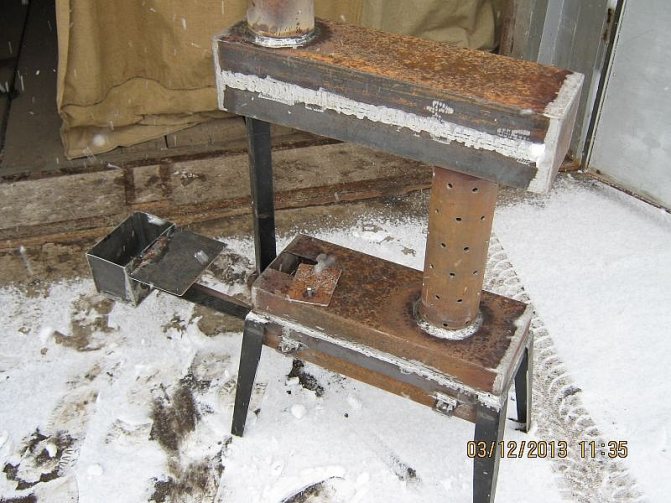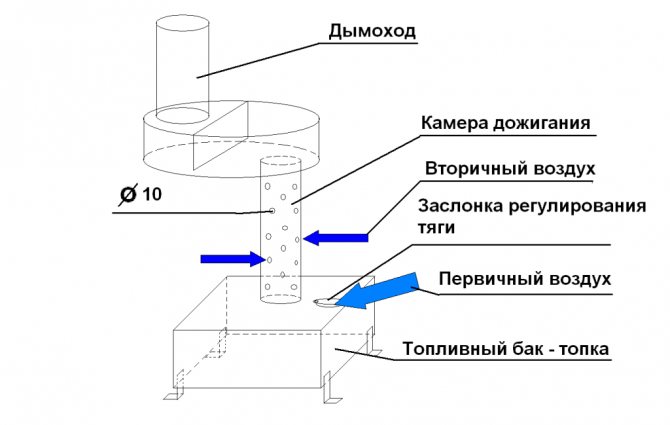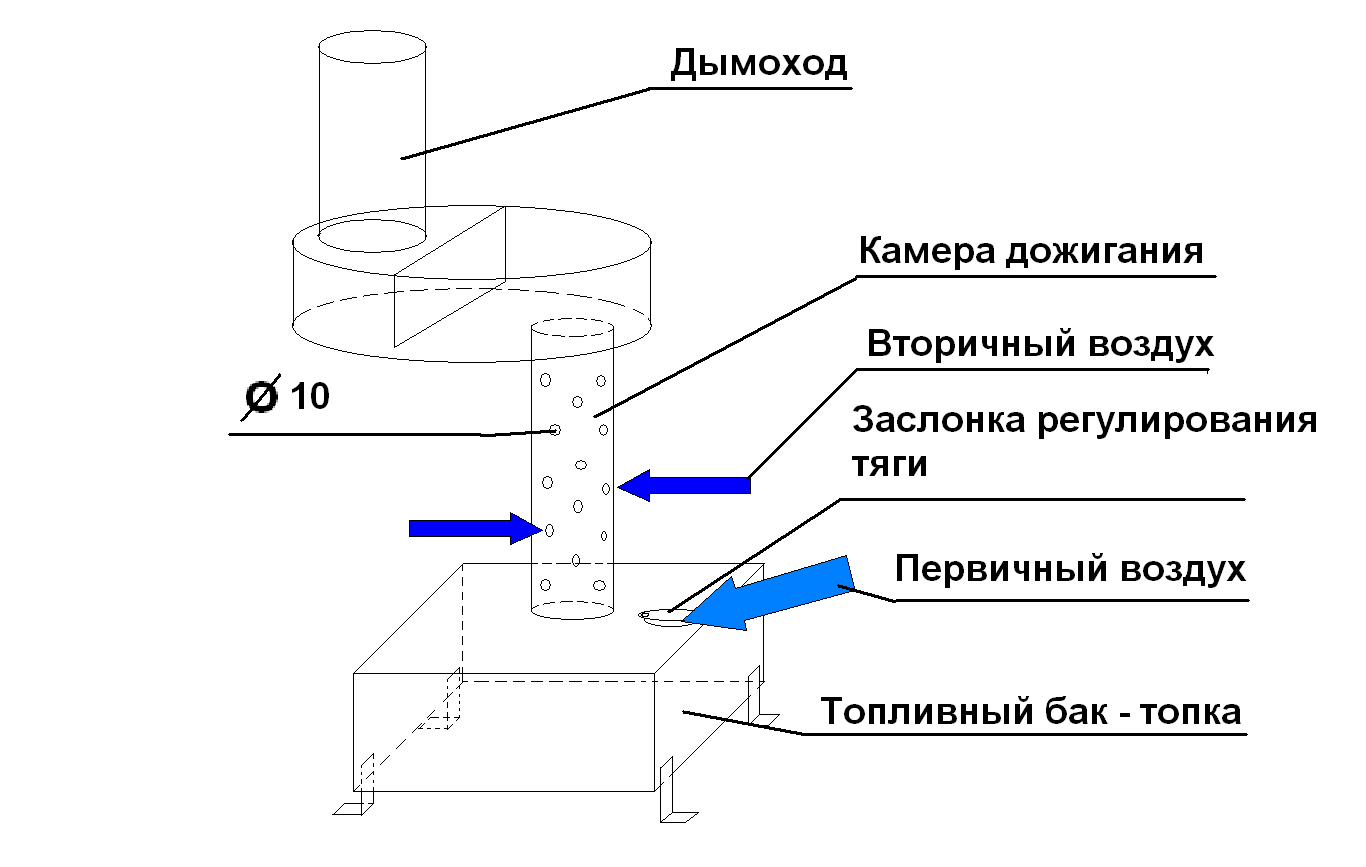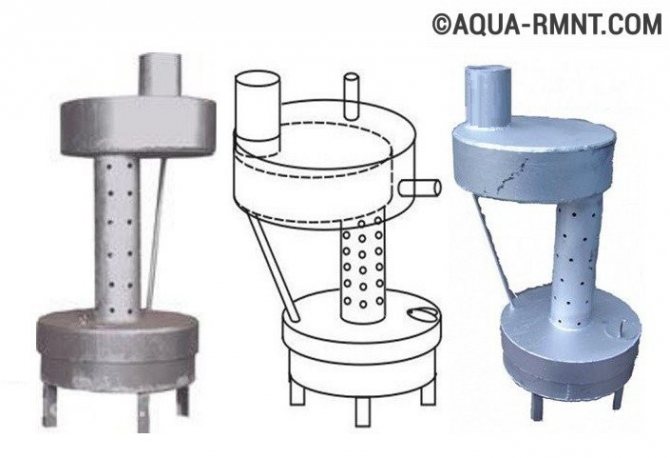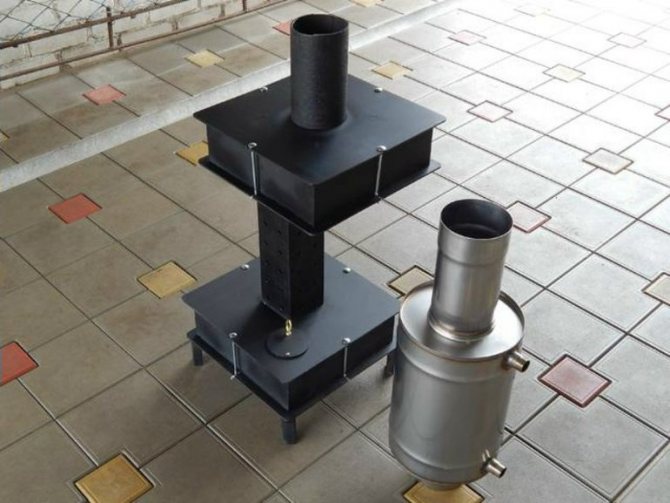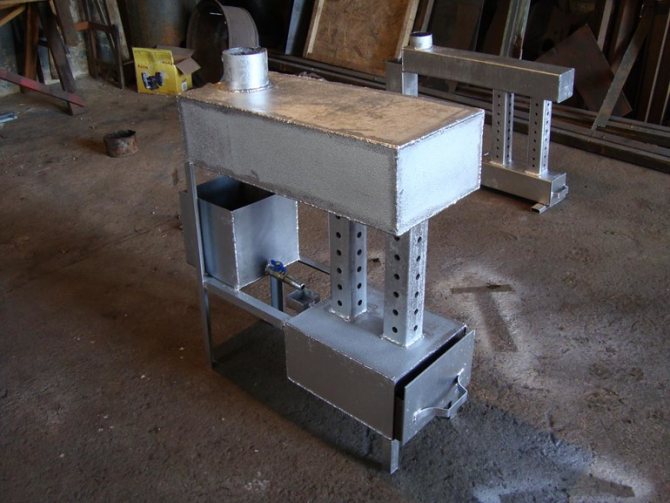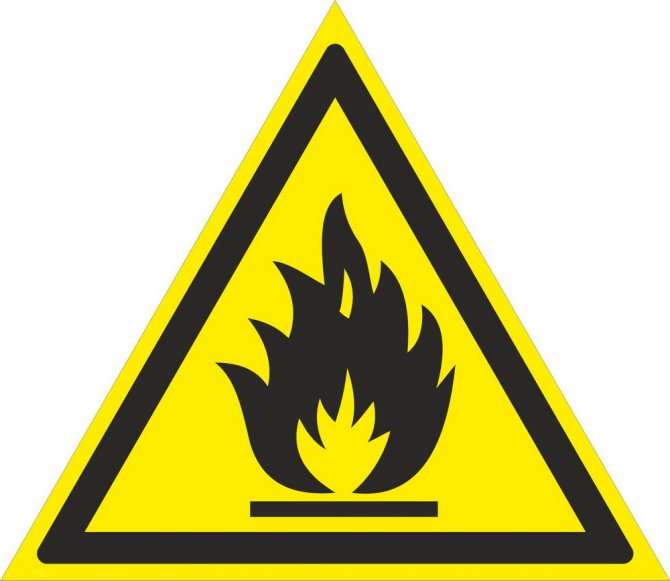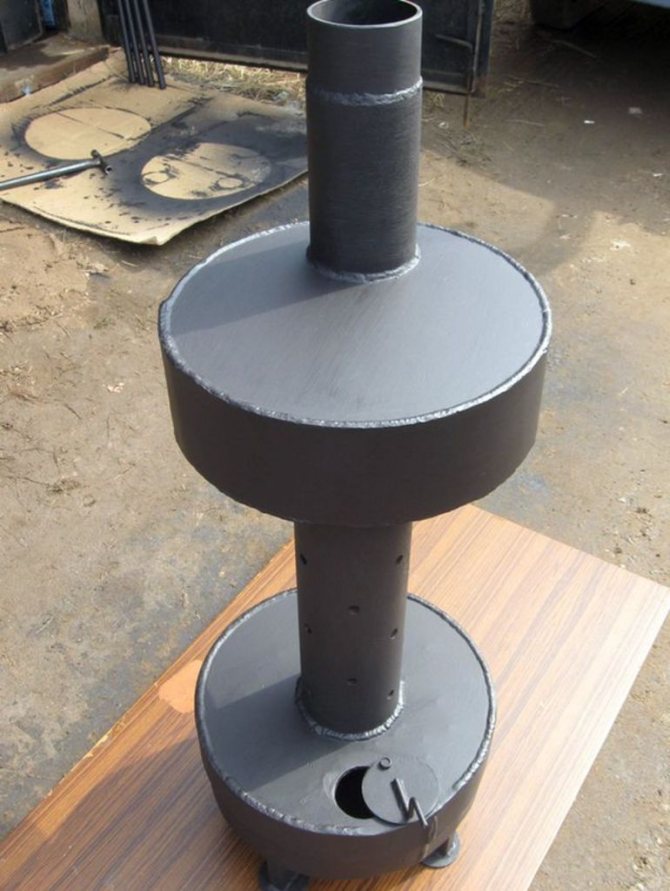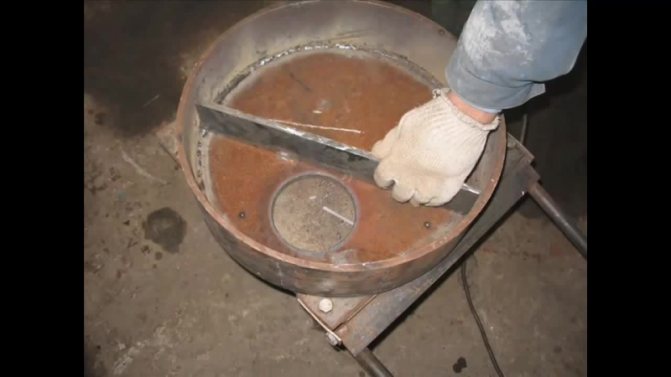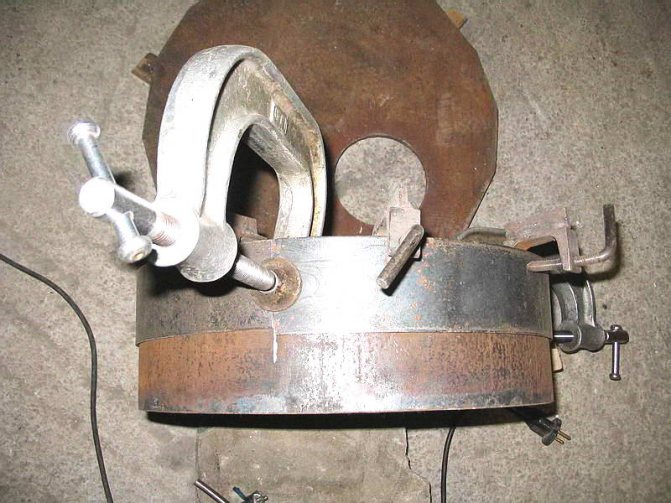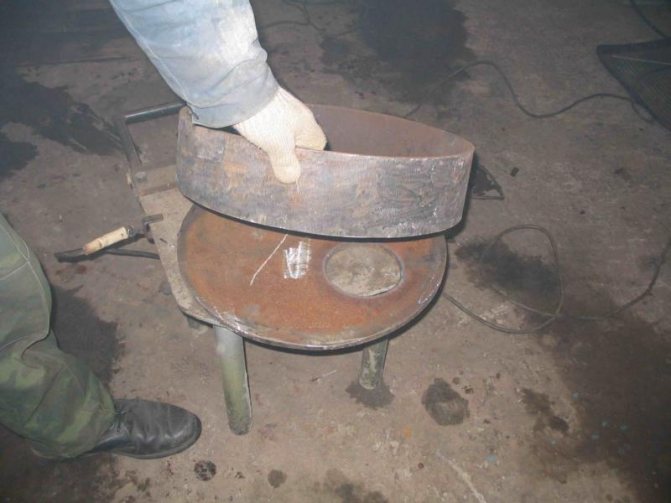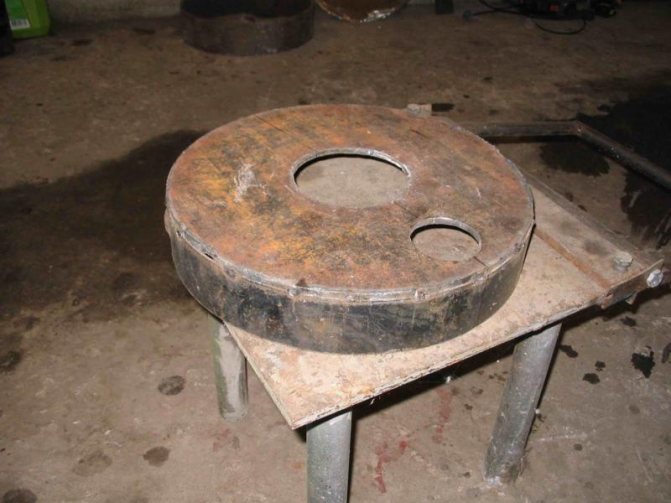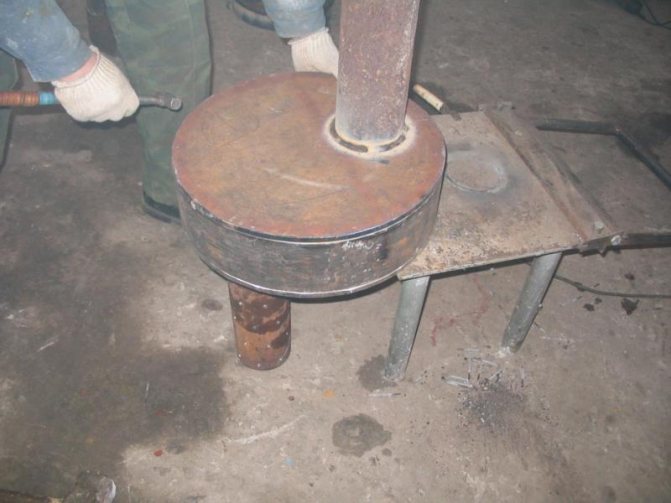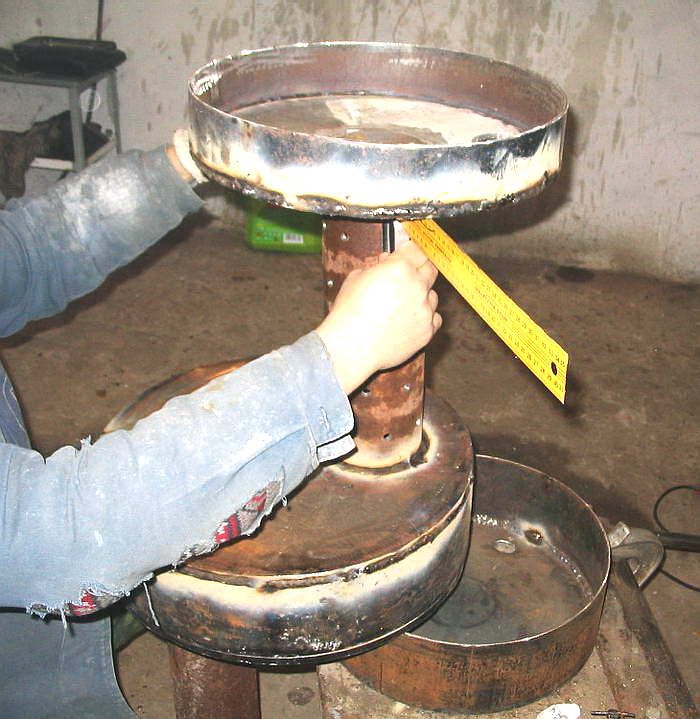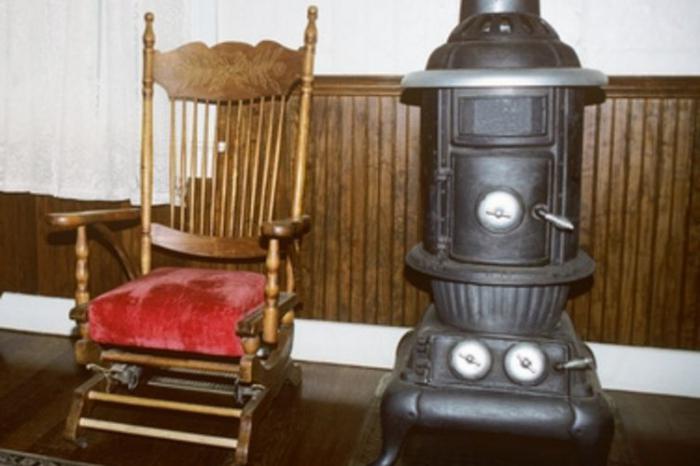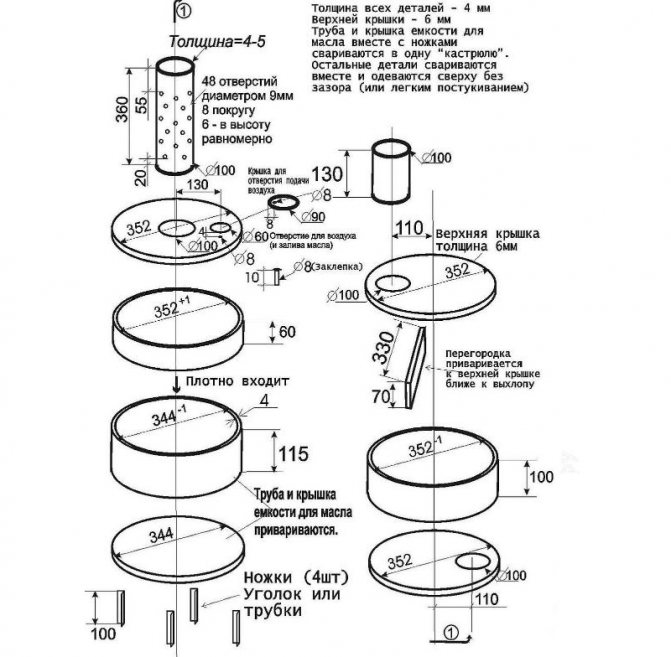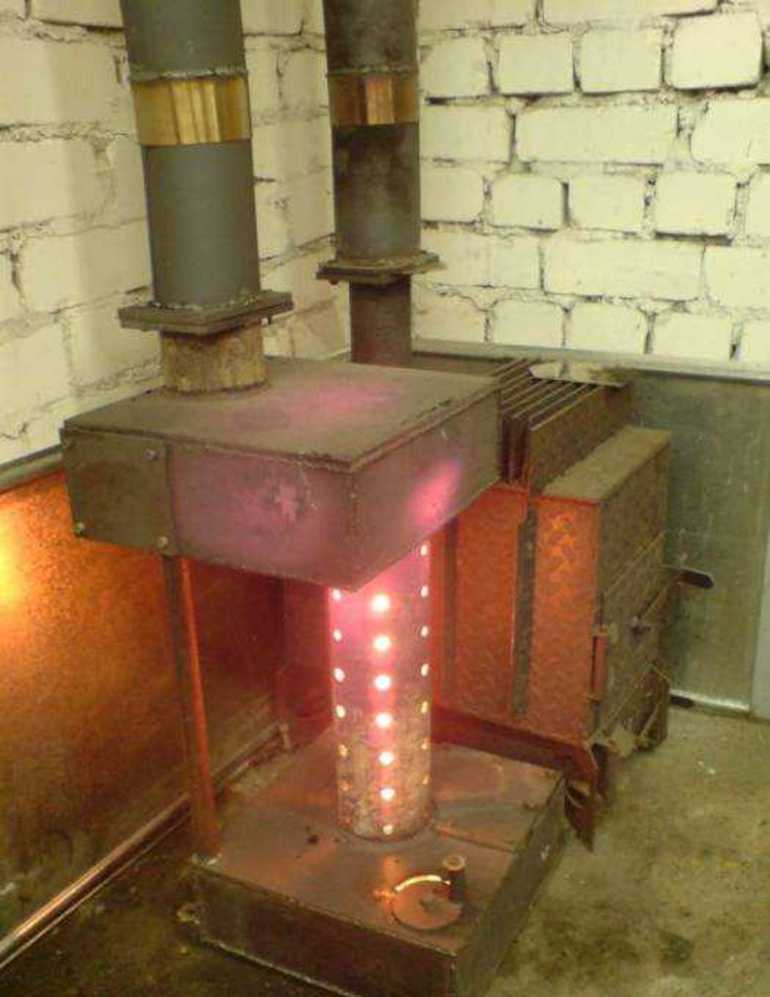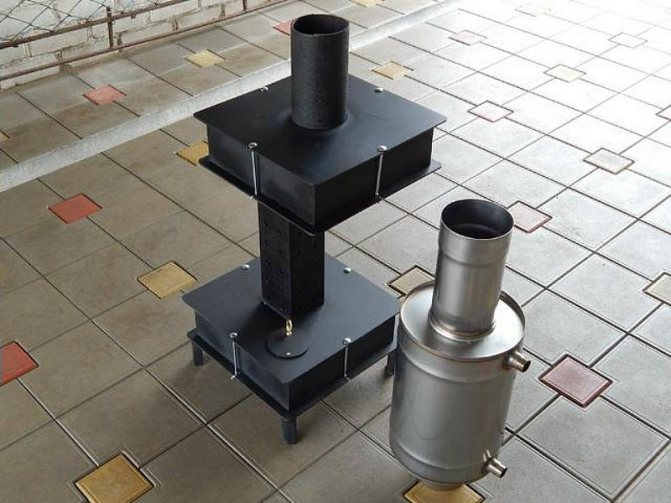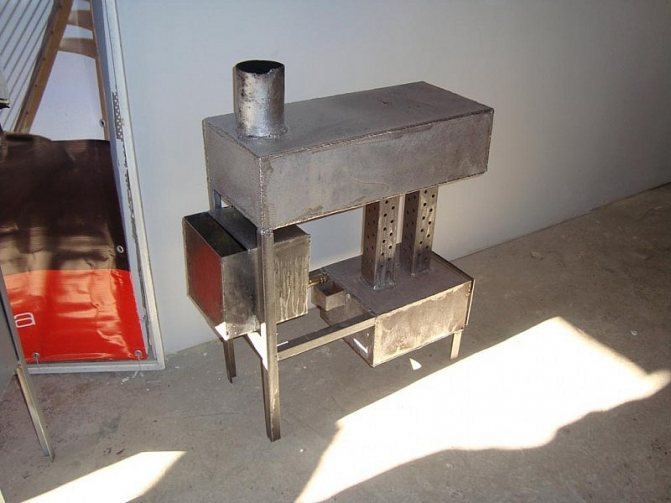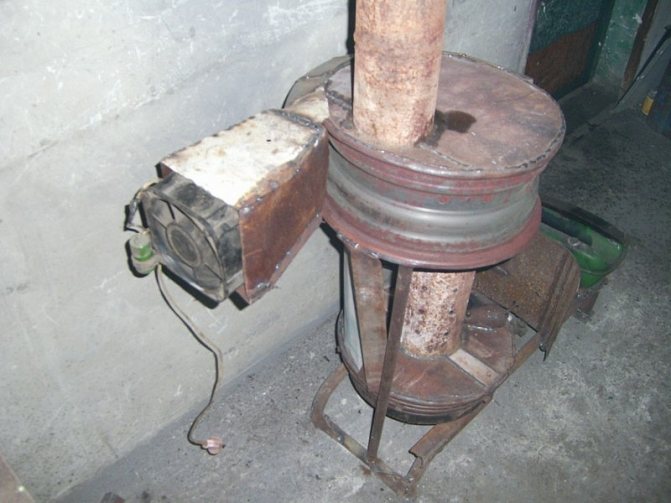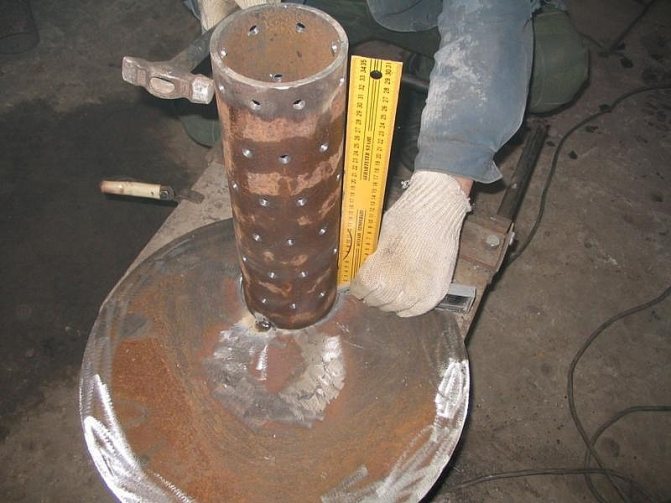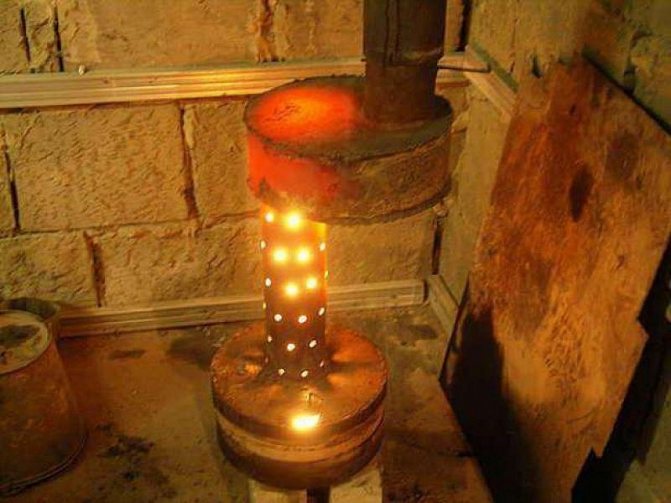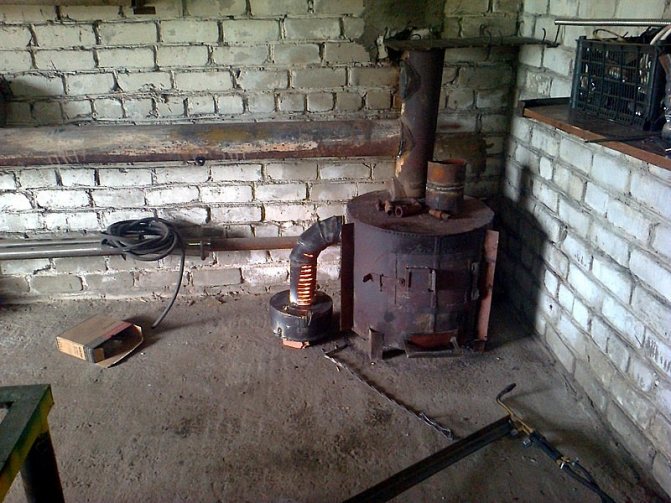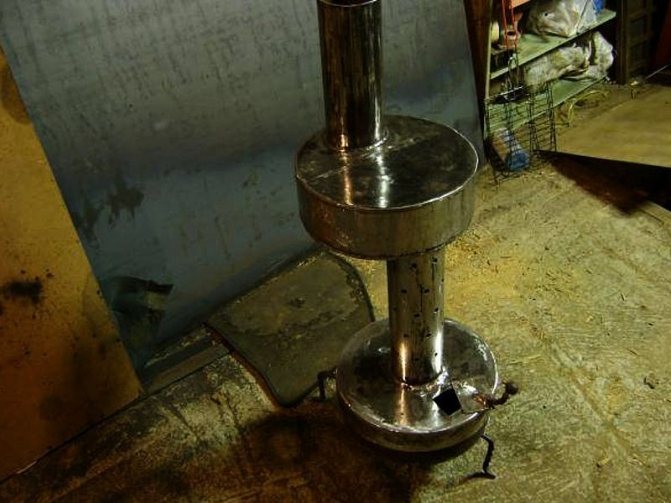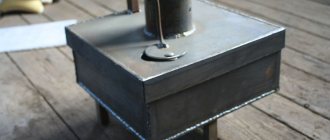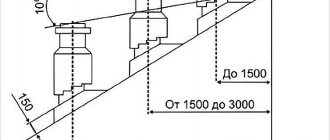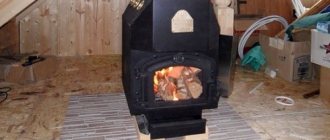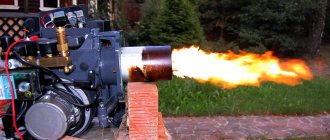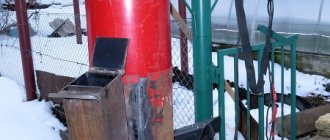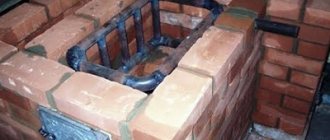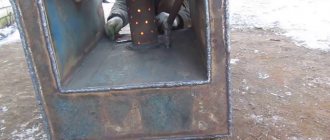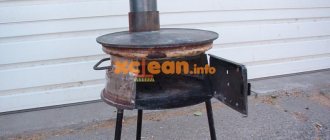The first potbelly stove appeared about 200 years ago in the form of a metal box or cylinder with legs with a pipe and a door. Such heating devices were bought only by wealthy people. Immediately after the fire was extinguished, both the stove and the room cooled down.
Modern versions of this heater are more efficient, in addition to firewood, they can use peat, coal and even waste industrial oil. Modern equipment has a slow burning function, air volume is regulated by doors, high temperature-resistant glass can be installed on the door of the firebox.
The principle of the potbelly stove
The work of the stove is based on the phenomenon of pyrolysis. In such a furnace, where the fuel is oil extraction, there are 2 main compartments: the tank and the combustion chamber, which are at different levels. The first is intended for pouring mining and its combustion.
In another compartment, located above, the combustion products of the working-out, mixed with air, are afterburned. At the first stage, the temperature is relatively moderate, and at the second stage it is much higher - up to 800⁰.
In the manufacture of such a furnace, the main task is to make sure that air flows into both compartments. It enters the first chamber through an opening for loading liquid fuel. The hole is equipped with a special damper, by means of which the volume of air supply is regulated.
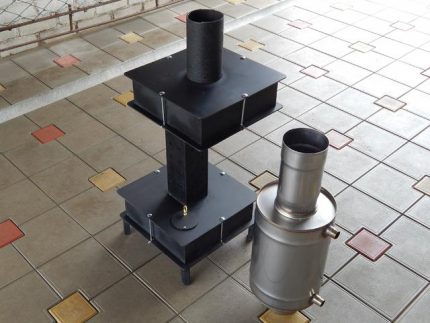
Despite the fact that the design of the stove is very simple, increased requirements are imposed on the stove chimney. For efficient removal of combustion products, it is necessary to prepare a straight pipe with a diameter of more than 10 cm and a length of more than 400 cm. Bends and horizontal sections are extremely undesirable. In addition to its direct purpose, the pipe also acts as a residual heat exchanger
Air access to the second tank is provided by holes with a diameter of about 9 mm. The efficiency of a correctly assembled potbelly stove reaches 90%. Visually different potbelly stoves can differ from each other both in shape and size, but the principle of operation is the same.
The power of the stove-stove is proportional to the volume of the lower tank. The more voluminous it is, the less often you will have to add mining. Sometimes this container is made very massive, containing about 30 liters of used oil.
Improvement of the simple design of the stove for testing made it possible to invent a unit for arranging a garage, in which it would be pleasant to wash your hands with hot water, or a small private bath:
Image gallery
Photo from
Enlarged afterburner chamber
Drawer bottom chamber
Convenient scheme for pouring mining
Practical hot water tank
Advantages and disadvantages of a potbelly stove
The models of these heating devices are different, but all have certain advantages:
- quickly melt and warm up the room;
- sufficiently high efficiency;
- heat spreads throughout the room evenly;
- you can buy for a relatively low cost;
- most of these products have a hob;
- it is cheaper to operate than using electrical appliances or wood-burning stoves.
The disadvantages of all models are also common:
- the room is warm only when the stove is heated;
- fuel must be added constantly;
- a high chimney is required, which must be cleaned frequently.
An interesting choice would be the manufacture of a miracle oven with diesel fuel. Details:
Creating a stove-stove from a gas cylinder
Another variant of the design of the furnace for development is a self-made stove-stove based on a 50-liter gas cylinder.In addition to this basic element, you need to prepare 2 steel pipes with a wall of about 4 mm and a diameter of 10 cm. One of them will remove the burning gases, and the second will act as a heat exchanger.
To this must be added a 4 mm steel sheet for the canopy over the heat exchanger and the baffle between the evaporator and the combustion chamber. For the vapor chamber itself, you need a brake disc from a car with such a diameter that it effortlessly enters the cylinder. A piece of 0.5-inch pipe is needed to transport oil to the combustion chamber.
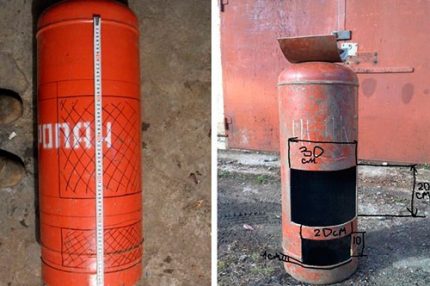

An excellent potbelly stove is obtained from a used cylinder. Although there is no gas in it, it is better to play it safe - to hold the cylinder outside for a while with the valve open. Lather is applied around the outlet. When it stops bubbling, the valve is twisted, if it is removable, if not, the condensate is drained in another way.
In addition, you should keep in stock an equilateral steel angle with a shelf of 50 mm and a length of more than 1 m, a 0.5 inch valve, clamps for sealing - 2 pcs., A hose, any cylinder equipped with a needle valve.
The work on creating a potbelly stove is performed in a certain order. First, the balloon is turned upside down and a small hole is drilled in it. A measure such as wetting the drill and drilling with oil will prevent sparking.
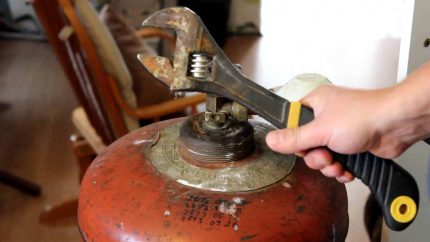

The valve is dismantled with a gas or adjustable wrench. After freeing the vessel from all residues, it can be cut, welded
The container is freed from gas condensate. Drain it carefully away from the housing, because its unpleasant smell persists for a long time. Then the workpiece is filled with water, after which it is drained again, thus removing the remaining gas. Since the mixture is explosive, there should be no source of open flame nearby.
Cut out in the body of the cylinder 2 rectangles of the same width, equal to 1/3 of the diameter of the workpiece. The height of the lower rectangle is 20 cm, the second, located 5 cm higher than the first, 40 cm. To separate the chambers, a circle with a diameter equal to the inner diameter of the vessel is cut out of the sheet.
A hole is made in its middle for a pipe with a diameter of 10 cm. This part will separate the combustion chamber from the heat exchanger.
A burner is made from a pipe 20 cm long and 10 cm in diameter. The lower part of it is perforated, making holes with a diameter of about 2 cm. The inside is cleaned from burrs, otherwise they will collect soot on themselves, which will significantly narrow the hole later.
A previously cut circle is put on the burner, placing it exactly in the middle, and welded. The structure is placed inside the stove and a weld is made around the circumference of the cylinder.
Weld the bottom and cover onto the car brake disc. This will be a drip tray or evaporator bowl. To supply fuel, an opening is left in the lid through which air will enter the stove. The opening is made quite wide, otherwise the thrust will decrease, and the oil will not get into the bowl.
Weld the pipe onto the top of the lid. A sleeve is made from a pipe with a diameter of 10 cm, which connects the bowl to the burner.
A fuel supply system is assembled, for which:
- make a receiving hole in the pallet;
- insert a 0.5-inch piece of water pipe into it at an angle of about 40⁰;
- weld the pipe to the furnace body;
- an emergency reserve valve is screwed to the pipe, the role of which is played by an ordinary water tap.
A heat exchanger is made from a pipe with a cross section of 10 cm. It is cut horizontally into the stove body, and a reflector is mounted at the end. Inflation is arranged by installing a duct fan at the end of the heat exchanger. The air driven through the heat exchanger with its help has a high speed.
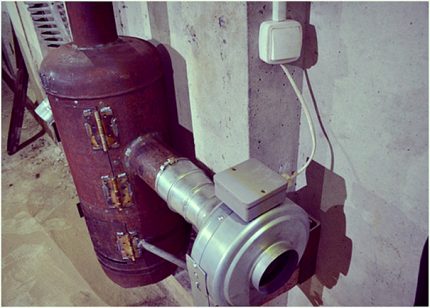

In order to make the system more controllable, it is automated by connecting a thermostat to a duct fan.This solution allows you to set the required temperature
An air swirler is placed inside the heat exchanger, consisting of triangular teeth connected by welding. A chimney is made from a pipe with a cross section of 10 cm.
It is welded into the hole located in the upper part of the furnace body and taken out through the wall to the roof of the building.
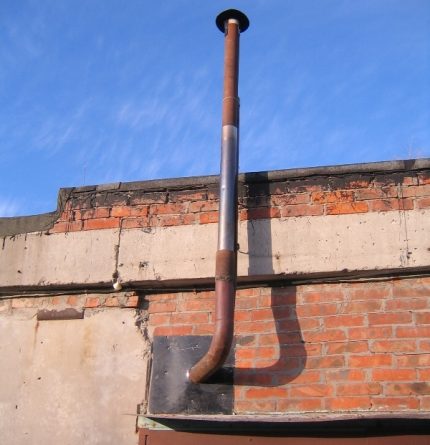

The section of the pipe passing through the enclosing structure is best placed in a refractory glass, and a metal sheet must be attached at the entry point
Next, they are engaged in the manufacture of an oil tank. If there is a freon-free cylinder with a serviceable needle valve, then it is quite suitable for this purpose. The vessel and the stove are connected by a hose connected to the valve. To fill the used oil, a hole is made in the tank body.
To provide air access to the burner and the evaporator bowl, a groove is selected in the door of the lower compartment. Thrust plates are attached to the upper chamber door opening, which ensures reliable sealing of the combustion chamber. For the same purpose, the door is additionally equipped with a lock.
Now, even if the stove body is deformed as a result of strong heating, the tightness of the combustion chamber will not be broken.
It remains to weld the legs from the corner pieces to the body and put the oven vertically. In addition to vertical stoves, horizontally located stoves are also made from a cylinder. Their structure is similar.
Work on other types of fuel
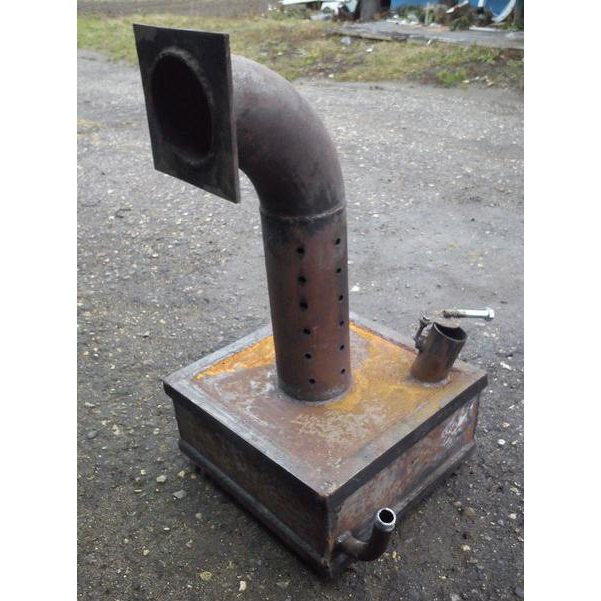

There is no need to bother with the exact observance of the millimeter size - many craftsmen collect potbelly stoves for working off "by eye", getting excellent results.
In our reviews, we have more than once published schemes for ordinary wood stoves, including the pyrolysis type. They are made from sheet iron or old gas cylinders. Equipped with large furnaces, they can burn almost any type of solid fuel. If you try, you can make a universal heating device - this is a wood-burning stove and working off.
To do this, you will need a mining burner, shown in the figure below. Here we see the same primary combustion chamber with a perforated vertical tube connected to it. Only the final afterburning will take place not in the secondary chamber, but in the chamber of the wood-burning stove. Your task is to arrange a removable door on it so that you can turn on the presented burner instead.
It is not difficult to remake a potbelly stove for mining - just use the schemes and tips published in our review.
Potbelly stove plus water circuit
Any home can use an emergency heat source. An ordinary, but slightly modernized potbelly stove can play its role. There are two ways to improve the furnace - to put a water jacket on the burner tube or wrap its body with a coil of copper pipes.
The coil turns are placed at a distance of about 5 cm from the perforated potbelly casing and connected to the general heating system. A reflective screen is installed around the coil. For its manufacture, sheet aluminum, galvanized steel, and tin are used.
The water jacket is a tank on the upper chamber of the stove. In its body there should be 2 fittings - one for the supply, and the other for the drainage of water. In general, the design resembles a samovar. The volume of the water jacket depends on the length of the heating system and the way of circulation of the coolant.
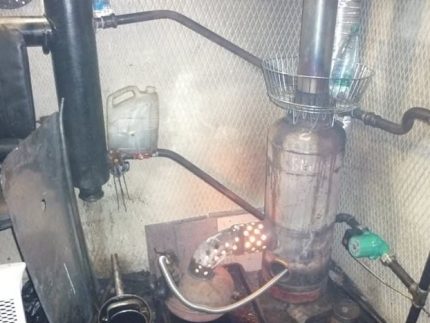

In practice, the issue of the device of the water circuit is solved by installing the container directly on the stove. Hot water enters the heating system through the outlet to the heating system. Having passed in a circle, it gives off heat to the room and returns back to the container.
If a pump is installed in the system, the volume of the tank is small, and with natural circulation it has impressive dimensions.To control the parameters of the water, a pressure gauge and a thermometer are installed on the tank.
Pros and cons
Like any heating device, a potbelly stove has its pros and cons. Its most important advantages:
- The minimum time required to heat the room. The metal walls of the unit warm up very quickly, giving off heat to the surrounding space.
- High efficiency.
- Uniform heating.
- Low cost, as well as the ability to make a potbelly stove with your own hands.
- Possibility of combining, for example, with a hob or a coil to create a water heating system.
- Cheapness and ease of use.
In order to objectively assess the effectiveness of a potbelly stove in a particular room, one should also take into account its disadvantages:
- The potbelly stove is not able to keep warm in the room. Immediately after the oven has cooled down, the air will also cool.
- You need to heat the stove constantly.
- For the normal removal of combustion products, a chimney of considerable length is required, which leads to rapid and frequent blockage of the pipe.
The potbelly stove is not suitable as a heating device that ensures constant temperature maintenance. But for rooms where it is periodically required to provide heat, it may be the best option.
https://www.youtube.com/watch?v=JerNAn7jYDk
Drip potbelly stove for mining
You can also make an economical model of a drip stove on your own. A small metal barrel or another container available on the farm is suitable for the case. A hole is made in the body through which oil will flow.
Next, take a burner with a capacity of about 2 liters, connect a copper tube 1 m long to its hose, and then fold it in half.
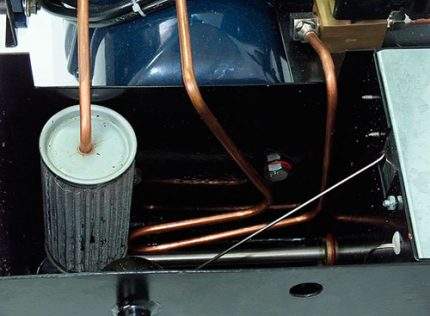

Such a unit, operating on waste oil products, can smoke, so the room in which it is installed must have good ventilation.
A hole is made in the container along the diameter of the tube. The tube itself is given the shape of the letter "L", and the burner is suspended.
Assembly directly
In the process of welding, special attention should be paid to the quality of the weld, since it is required to make a container completely sealed at the joints in order to prevent fuel leakage. The container is obtained by cutting a strip that is folded into an even circle and welded, and cutting out two circles that serve as a bottom and a lid
In this case, two holes are required in the lid. The first is for the pipe diameter, the second is for oil filling and for air flow.
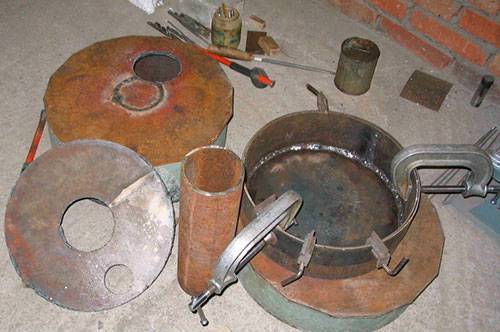

Each part is manufactured individually. Final assembly takes place at the final stage
The second container is made in a similar way, with the only difference that a piece of rectangular metal with a length slightly less than the diameter should be welded into it, which will serve as a partition between the chamber itself and the chimney pipe. In the second container in the bottom, a hole should be made for the pipe connecting chamber, and in the lid, an opening for the chimney pipe is required.
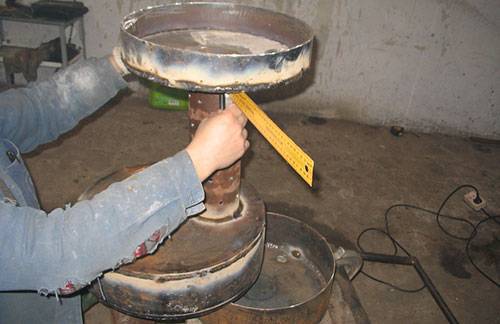

During the installation process, one should be guided by the proverb "measure seven times - cut one", so as not to get out of size
After the manufacture of both chambers, you should take care of the pipe for the burner, in which it is necessary to drill a certain number of holes, while it should be borne in mind that the more there are, the stronger the air flow will be, and the more active the combustion process will be, but there are too few holes will not create the required thrust.
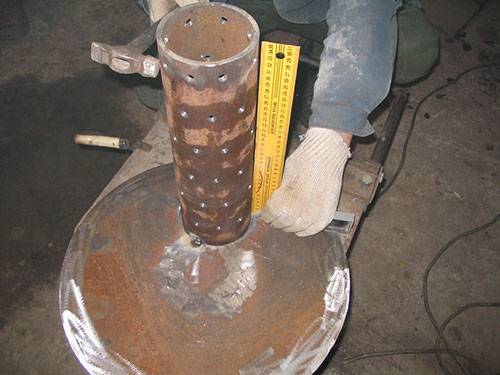

A number of holes should be made in the pipe leading to the upper tier and then welded to other elements
The final, final stage will be the final assembly of all parts into a single structure with the obligatory thorough welding of all seams, observing complete tightness. The only part left removable is the top chamber cover.Lastly, a chimney pipe is installed, which is not recommended to be installed in a horizontal plane, it is best to use a small angle, and for greater rigidity and strength of the structure, connect the pipes to the lower fuel tank by means of steel reinforcement or rods.
Most often, a potbelly stove, working on mining, is installed on legs, which are made of metal corners of a small length, welded to the bottom.
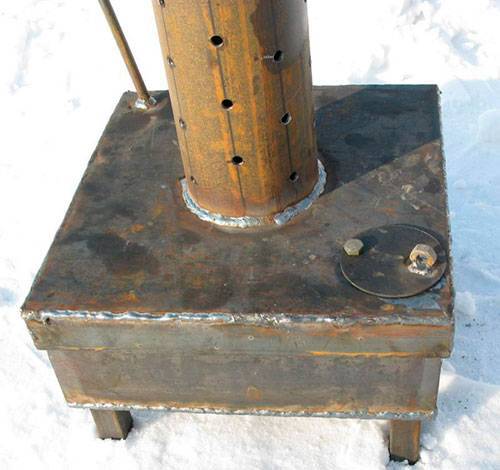

The supporting elements of the entire oven are a metal corner welded to the bottom "pan"
The process of making a stove based on an old potbelly stove is practically no different. The only thing is that the fuel tank is installed in the combustion chamber of the stove, and all the dampers, ash pans and the furnace door are welded. When installing a furnace for mining in a stove, the most convenient way to fill in oil is by removing the fuel tank from the furnace.
The following publications will perfectly complement this material:
- Features of using a wood-burning stove in the country
- Diy long burning potbelly stove: step by step instructions
Alteration of a solid fuel potbelly stove for mining
When the farm already has a potbelly stove, but is not satisfied with the fact that it runs on solid fuel, you can modernize it and it will become universal. For this, a prefix is made, resembling in its design a stove on processing in its lower part.
There is also a perforated pipe here, but not straight, but bent at a right angle. It is connected to the side wall of the furnace, which serves as the final combustion chamber. If the potbelly stove door is welded and a hole is made in it for the pipe to enter, then the furnace will only work on working off.
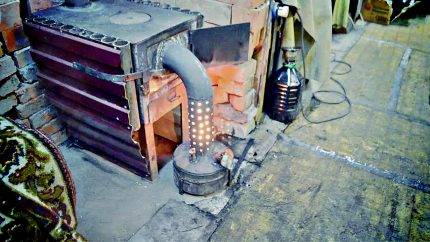

The modernization of this oven consists not only in complementing it with a special attachment, but also in the original solution to protect nearby objects from fire, using the principle of convection. For this, pipes were welded to the side wall of the furnace. Cold air entering them from below cools the structure
To be able to use not only technical oil for heating, but also firewood, two replaceable doors are made. The standard one is hung when it is planned to lay firewood, and the modernized one with a corresponding hole - when the stove will operate on waste oil.
We also offer you to read an article on how to collect a potbelly stove using waste oil from a pipe - to familiarize yourself with the material, follow the link.
Making a simple potbelly stove with your own hands
The basic design of a handmade potbelly stove consists of 4 parts:
- A fuel tank of any shape with a hole in the center, the diameter of which is equal to the corresponding size of the pipe to be connected. Here the mining starts burning. The metal for the manufacture of this structural element must be at least 3 mm thick.
- Combustion chamber or injector, which is a vertical cylindrical container with a number of holes, connected through a hole to the tank. As a result of replenishment with air through the perforated walls of the injector, the fuel entering the chamber burns out completely.
- A heat exchanger in the form of a tank located above the combustion chamber. A heated gas mixture enters it. The design can be of any size and shape. Ideally, this is a tank with a hollow area where you can reheat food.
- Smoke exhaust pipes for efficient draft.
To make a potbelly stove yourself, you need to have good welding skills. Welding seams must ensure tightness.
Manufacturing of a development tank
An unusable gas cylinder or canister with thick walls can serve as an alternative to a welded tank, but in any case, 3 basic requirements are mandatory:
- The structure must be at least partially demountable for the possibility of its periodic cleaning.
- The hole for connecting the injector must be centered.
- The hatch for pouring the mining should be equipped with an adjusting flap on a bolted connection. With its help, the intensity of combustion is regulated.
The easiest way to make a tank is from large diameter pipes. The bottom and legs are welded to one piece of pipe with a diameter of about 35 cm. In order to close the tank, they take a small piece of pipe of a slightly larger diameter, weld a lid to it, then make 2 holes in it - one with a control diameter of about 60 mm, and the other for an injector.
The height of the side of the 2 part should be 1/3 of the height of the lower container. The total height of the tank, measured from its bottom to the central hole on the lid, is 10-15 cm.
The fuel is ignited in the tank using paper or cloth dipped in kerosene. They are set on fire and lowered into the container through the control hole. The waste will have to be constantly refilled in order to maintain the level of 2/3 of the tank height.
How to make an injector?
The optimal pipe diameter for the manufacture of the injector is 10 cm, the minimum wall thickness is 0.8 cm. To calculate its height, the length of the chimney pipe is taken, divided by 10. Five percent is subtracted from the result and the required value is obtained. It should be between 36 - 38 cm. This is a condition for normal traction.
The holes made in the walls of the pipe in a checkerboard pattern or simply evenly distributed over the surface have a diameter of 0.9 - 0.95 cm. From the bottom and top of the pipe, indentations of 2 - 2.5 cm and 5.5 - 6 cm are made, respectively.
Basic version of the heat exchanger
The minimum wall thickness of the heat exchange tank is 0.3 cm. It is made using the same technology as the fuel tank. It is better to make the top flat, and the hole for the chimney must be displaced, then it will be possible, if necessary, to put a frying pan or kettle on the stove.
A partition is made inside the hollow vessel, creating a labyrinth for better heat transfer. Moreover, the thicker this part, the hotter the surface of the stove-stove will be. In order to clean the heat exchanger from carbon deposits, a special hatch is made on the side and closed with a lid.
A channel is welded onto the hole intended for the chimney - a pipe with a height of 5 to 10 cm and a diameter of 10 cm.
What to make a chimney from?
In order for the combustion products exiting through the pipe to have a temperature as low as possible, that part of the pipe that is located in the room must be made of steel. Due to this, the smoke gives its temperature to the walls of the chimney, cools down, increasing the residual heat exchange.
An ordinary tin pipe can serve as a continuation of the chimney from the outside, but it will have to be insulated to prevent the accumulation of soot during the cold period. An insulated pipe is a better option, but more expensive. It is not necessary to seal the joints of the pipe sections.
The pipes themselves can be of different diameters, but the one with the smaller diameter is connected directly to the furnace. And how to make a chimney for a stove on your own, read on.
Secrets of the successful operation of a potbelly stove
In order for a stove stove running on waste oil to work efficiently and safely, you need to adhere to a few tips. The oil must be allowed to stand before use. Pour it into the oil tank for 2/3 of the volume of the latter.
For safety reasons, all elements of the stove should be cleaned regularly. To simplify this task, its top module should be removable. This will provide access to the combustion chamber. To remove soot from the walls of the chimney, it should be tapped.
In order to extend the service life of the combustion chamber and the furnace as a whole, it must be painted using paints that are resistant to high temperatures. The stove should be installed on a non-flammable base. It should not be placed in a draft, under the influence of which the flame may escape.
Operation and working principle
Do-it-yourself potbelly stove is the most affordable, easy-to-assemble and inexpensive option to operate, which practically does not differ from the classic and well-known variation. The stove, for which the oil will only be used, will thereby allow you to save a lot of money, and in order for such a heating unit to start its work, oil must be poured into a special compartment in the shape of a pipe. Here it will burn out and be converted into gas, which will pass further into the combustion chamber and mix with air masses.
The combustion chamber of the gas formed during combustion is located in the upper part of the pipe, with which such a heater is necessarily equipped, and the speed and quality of heating directly depends on the dimensions of the combustion chamber of your stove. If the chamber is very large, you will need many times more fuel, but the intensity and speed of heating in this case will be at the highest level.
The potbelly stove, with which the garage will be heated intensively, quickly and evenly, allows the oil to initially burn out at sufficiently low temperatures, which increase significantly at the moment of repeated burning, already being gases and mixing with air. The maximum temperature of the exhaust gases in the second chamber can reach about 750-85 degrees, due to which the garage is heated, and additional heat energy comes from the mounted chimney, the surface of which also warms up well and gives off heat.
The waste oil furnace consists of three main structural components, which you can find in more detail below:
- The lowest compartment of the waste oil stove structure consists of a round tank, into which oil is poured; the optimum dimensions of this element will be a diameter of 3.5-4.5 centimeters. Such dimensions are enough so that the poured oil burns out intensively and evenly gives off heat to heat the garage;
- The second structural element of the waste oil stove is a tank in which the re-burning is carried out, but not oil, but the resulting gases mixed with oxygen. The dimensions of this element are selected individually and can be equal to the first compartment, in the upper part of the second tank it is necessary to leave a slot, the hole that will go into the chimney;
- The third structural element of the potbelly stove for mining is a pipe that is connected to the second chamber and has a diameter of only 1.5-2 centimeters, and in order for the exhaust gases to be saturated with oxygen, it is necessary to drill many small holes in such a pipe.
A potbelly stove, a drawing of which is thought out independently or found on a specialized resource, will serve you for many years and will not fail, if at the initial stage you become familiar with the basic requirements and rules for the operation of such a heating unit. Used oil must be poured into the reservoir for it up to the ½-1/3 mark, but not completely, since during the heating process it will boil and sprinkle, which can lead to it getting on flammable surfaces and fire. Also, after the oil has been used up, before using it in a stove, it is necessary to let it settle well for at least a few hours.
It is better to make the top of such a design removable from the beginning, so that, if necessary, it is possible to carry out a simple cleaning of the inner surface of the heating unit from combustion and decay products deposited on the walls. In order to remove decay products from a narrow chimney, you can use a special brush with a long handle, as well as make tapping, which will allow the accumulated soot to fall off.
Also, in order to extend the service life of the stove stove on waste oil, it is necessary to paint it after assembly with a special heat-resistant paint, which in the future will not allow the body to rot, deform, and form rust and corrosion.
